Corporate Finance Report: Impact of Dividends on Bukit Darah PLC
VerifiedAdded on 2020/02/24
|16
|3387
|88
Report
AI Summary
This report provides a detailed analysis of Bukit Darah PLC's corporate finance, focusing on its dividend policy and hedging strategies. It examines the company's financial structure, including its economic and financial resources, and evaluates its dividend payout ratio and dividend yield. The report explores the theories behind dividend policy, including the Modigliani and Miller theory and the Gordon model, and offers recommendations for improving the company's practices. Furthermore, it addresses Bukit Darah PLC's exposure to foreign exchange risk and discusses both internal and external hedging strategies, including the importance of derivatives. The analysis concludes with an assessment of the company's financial decisions and the potential impact of various management strategies.
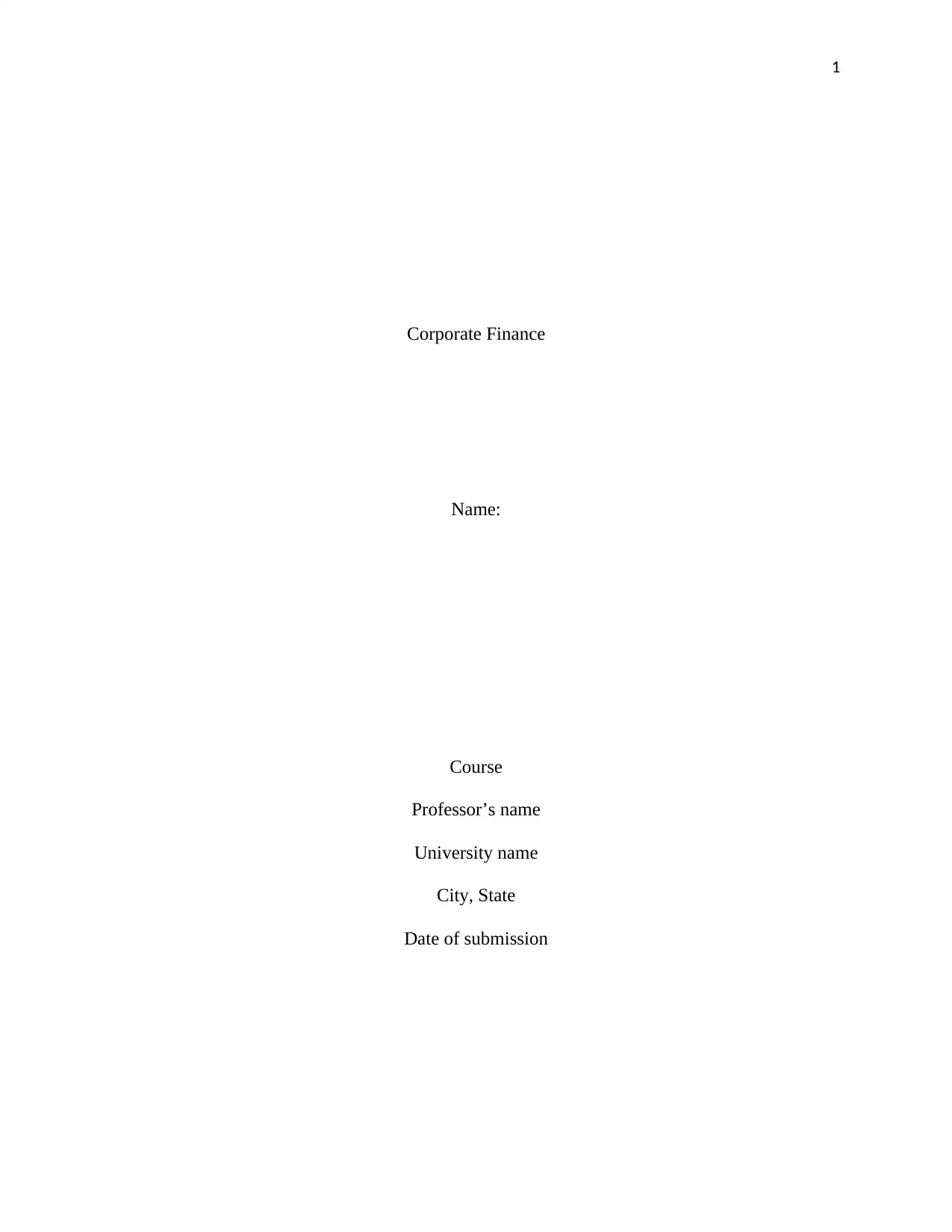
1
Corporate Finance
Name:
Course
Professor’s name
University name
City, State
Date of submission
Corporate Finance
Name:
Course
Professor’s name
University name
City, State
Date of submission
Paraphrase This Document
Need a fresh take? Get an instant paraphrase of this document with our AI Paraphraser
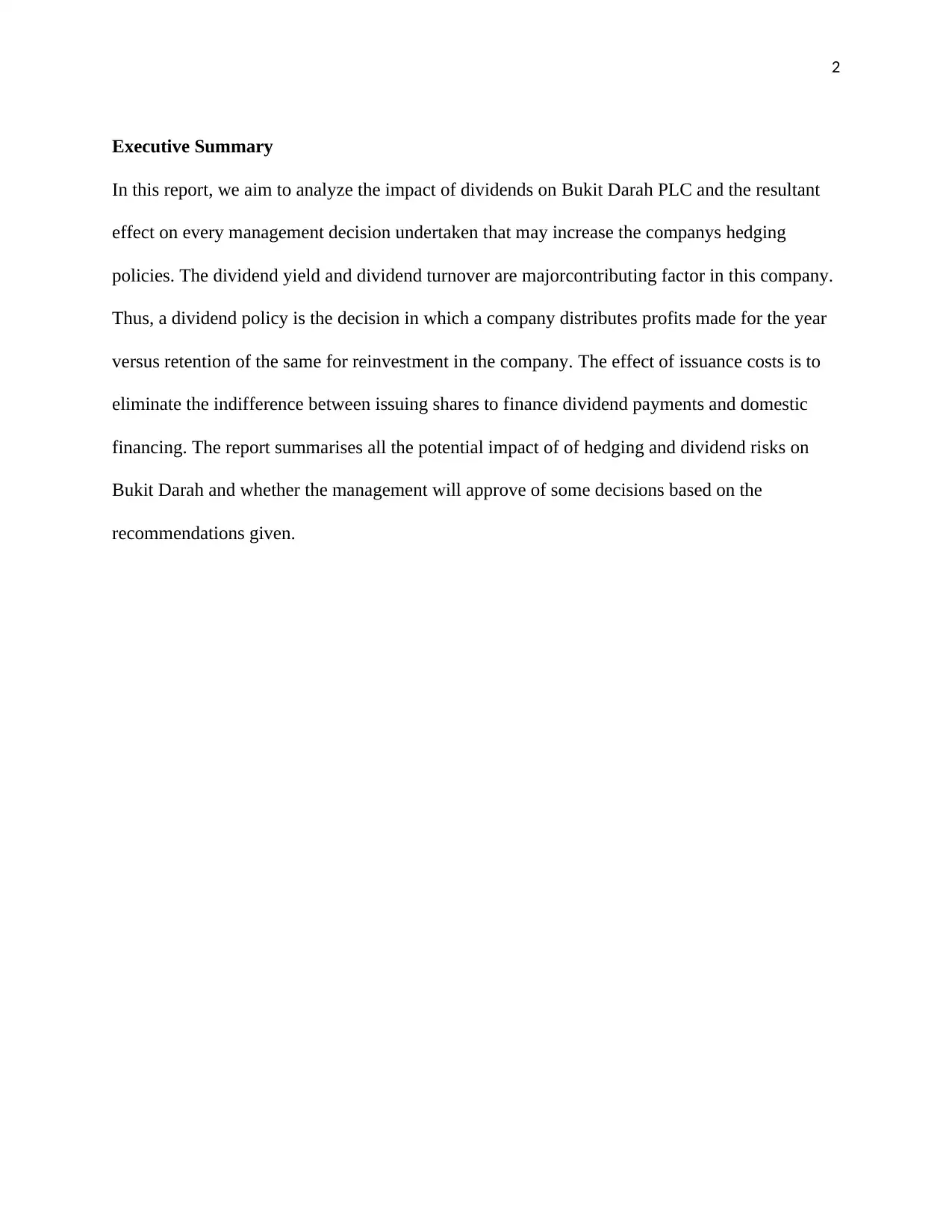
2
Executive Summary
In this report, we aim to analyze the impact of dividends on Bukit Darah PLC and the resultant
effect on every management decision undertaken that may increase the companys hedging
policies. The dividend yield and dividend turnover are majorcontributing factor in this company.
Thus, a dividend policy is the decision in which a company distributes profits made for the year
versus retention of the same for reinvestment in the company. The effect of issuance costs is to
eliminate the indifference between issuing shares to finance dividend payments and domestic
financing. The report summarises all the potential impact of of hedging and dividend risks on
Bukit Darah and whether the management will approve of some decisions based on the
recommendations given.
Executive Summary
In this report, we aim to analyze the impact of dividends on Bukit Darah PLC and the resultant
effect on every management decision undertaken that may increase the companys hedging
policies. The dividend yield and dividend turnover are majorcontributing factor in this company.
Thus, a dividend policy is the decision in which a company distributes profits made for the year
versus retention of the same for reinvestment in the company. The effect of issuance costs is to
eliminate the indifference between issuing shares to finance dividend payments and domestic
financing. The report summarises all the potential impact of of hedging and dividend risks on
Bukit Darah and whether the management will approve of some decisions based on the
recommendations given.
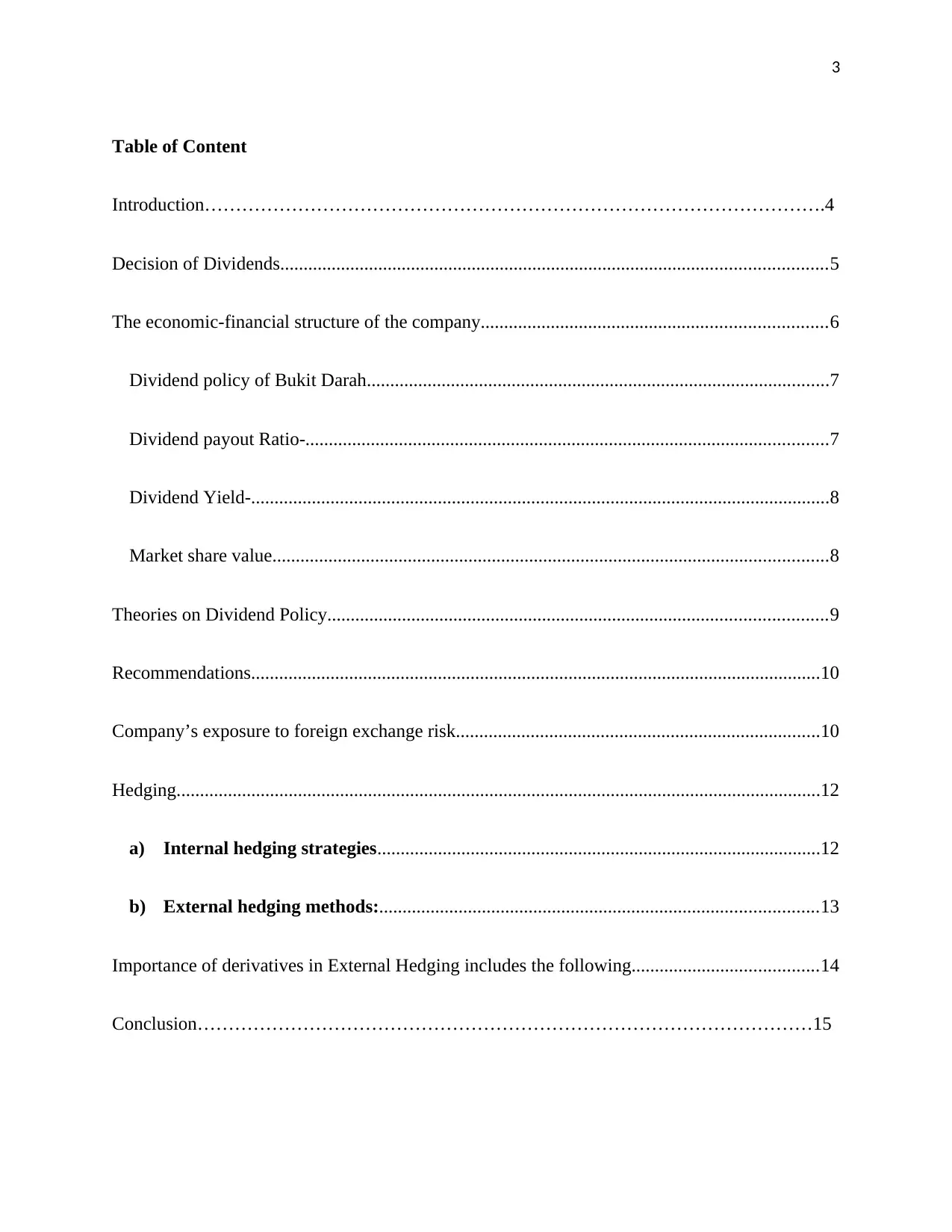
3
Table of Content
Introduction……………………………………………………………………………………….4
Decision of Dividends.....................................................................................................................5
The economic-financial structure of the company..........................................................................6
Dividend policy of Bukit Darah...................................................................................................7
Dividend payout Ratio-................................................................................................................7
Dividend Yield-............................................................................................................................8
Market share value.......................................................................................................................8
Theories on Dividend Policy...........................................................................................................9
Recommendations..........................................................................................................................10
Company’s exposure to foreign exchange risk..............................................................................10
Hedging..........................................................................................................................................12
a) Internal hedging strategies...............................................................................................12
b) External hedging methods:..............................................................................................13
Importance of derivatives in External Hedging includes the following........................................14
Conclusion………………………………………………………………………………………15
Table of Content
Introduction……………………………………………………………………………………….4
Decision of Dividends.....................................................................................................................5
The economic-financial structure of the company..........................................................................6
Dividend policy of Bukit Darah...................................................................................................7
Dividend payout Ratio-................................................................................................................7
Dividend Yield-............................................................................................................................8
Market share value.......................................................................................................................8
Theories on Dividend Policy...........................................................................................................9
Recommendations..........................................................................................................................10
Company’s exposure to foreign exchange risk..............................................................................10
Hedging..........................................................................................................................................12
a) Internal hedging strategies...............................................................................................12
b) External hedging methods:..............................................................................................13
Importance of derivatives in External Hedging includes the following........................................14
Conclusion………………………………………………………………………………………15
⊘ This is a preview!⊘
Do you want full access?
Subscribe today to unlock all pages.

Trusted by 1+ million students worldwide
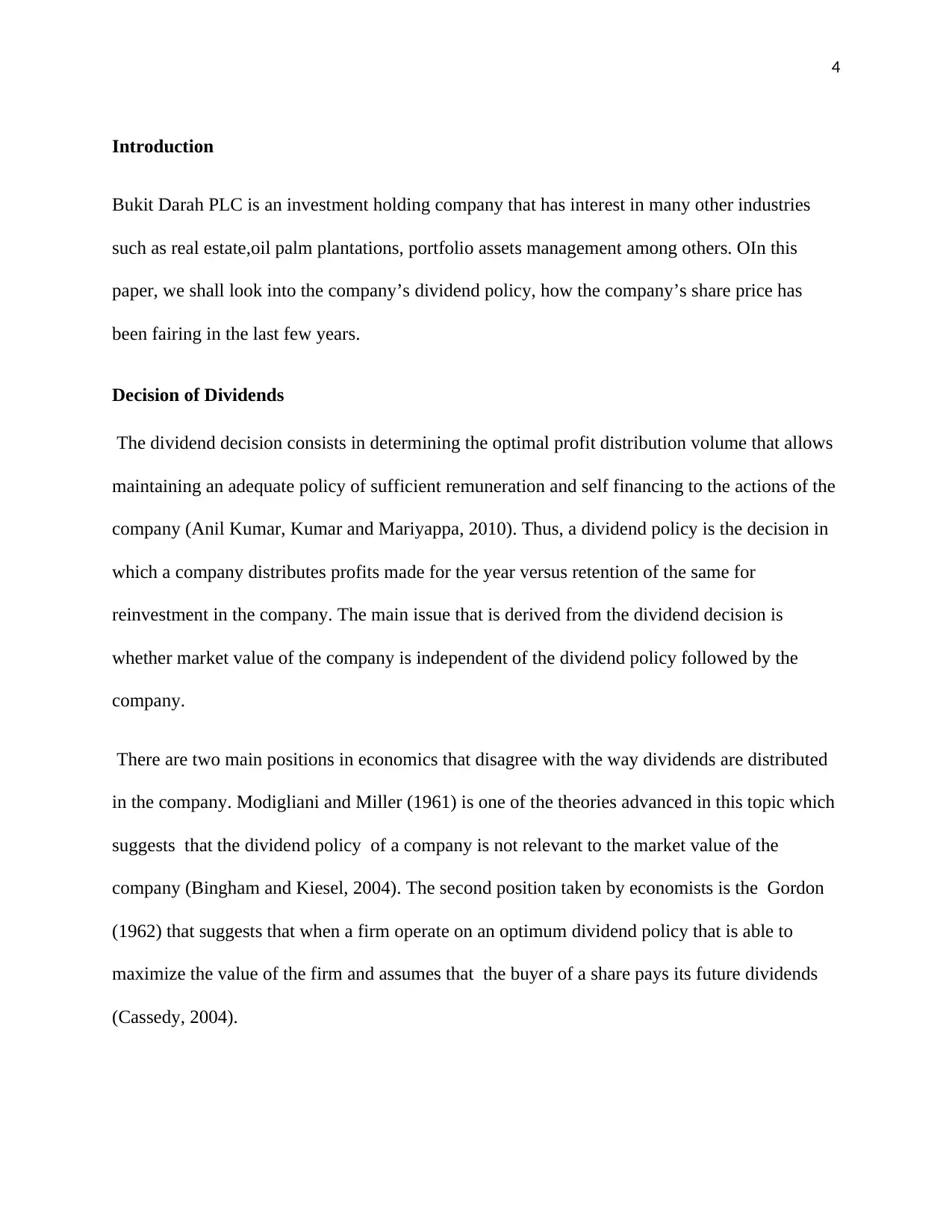
4
Introduction
Bukit Darah PLC is an investment holding company that has interest in many other industries
such as real estate,oil palm plantations, portfolio assets management among others. OIn this
paper, we shall look into the company’s dividend policy, how the company’s share price has
been fairing in the last few years.
Decision of Dividends
The dividend decision consists in determining the optimal profit distribution volume that allows
maintaining an adequate policy of sufficient remuneration and self financing to the actions of the
company (Anil Kumar, Kumar and Mariyappa, 2010). Thus, a dividend policy is the decision in
which a company distributes profits made for the year versus retention of the same for
reinvestment in the company. The main issue that is derived from the dividend decision is
whether market value of the company is independent of the dividend policy followed by the
company.
There are two main positions in economics that disagree with the way dividends are distributed
in the company. Modigliani and Miller (1961) is one of the theories advanced in this topic which
suggests that the dividend policy of a company is not relevant to the market value of the
company (Bingham and Kiesel, 2004). The second position taken by economists is the Gordon
(1962) that suggests that when a firm operate on an optimum dividend policy that is able to
maximize the value of the firm and assumes that the buyer of a share pays its future dividends
(Cassedy, 2004).
Introduction
Bukit Darah PLC is an investment holding company that has interest in many other industries
such as real estate,oil palm plantations, portfolio assets management among others. OIn this
paper, we shall look into the company’s dividend policy, how the company’s share price has
been fairing in the last few years.
Decision of Dividends
The dividend decision consists in determining the optimal profit distribution volume that allows
maintaining an adequate policy of sufficient remuneration and self financing to the actions of the
company (Anil Kumar, Kumar and Mariyappa, 2010). Thus, a dividend policy is the decision in
which a company distributes profits made for the year versus retention of the same for
reinvestment in the company. The main issue that is derived from the dividend decision is
whether market value of the company is independent of the dividend policy followed by the
company.
There are two main positions in economics that disagree with the way dividends are distributed
in the company. Modigliani and Miller (1961) is one of the theories advanced in this topic which
suggests that the dividend policy of a company is not relevant to the market value of the
company (Bingham and Kiesel, 2004). The second position taken by economists is the Gordon
(1962) that suggests that when a firm operate on an optimum dividend policy that is able to
maximize the value of the firm and assumes that the buyer of a share pays its future dividends
(Cassedy, 2004).
Paraphrase This Document
Need a fresh take? Get an instant paraphrase of this document with our AI Paraphraser
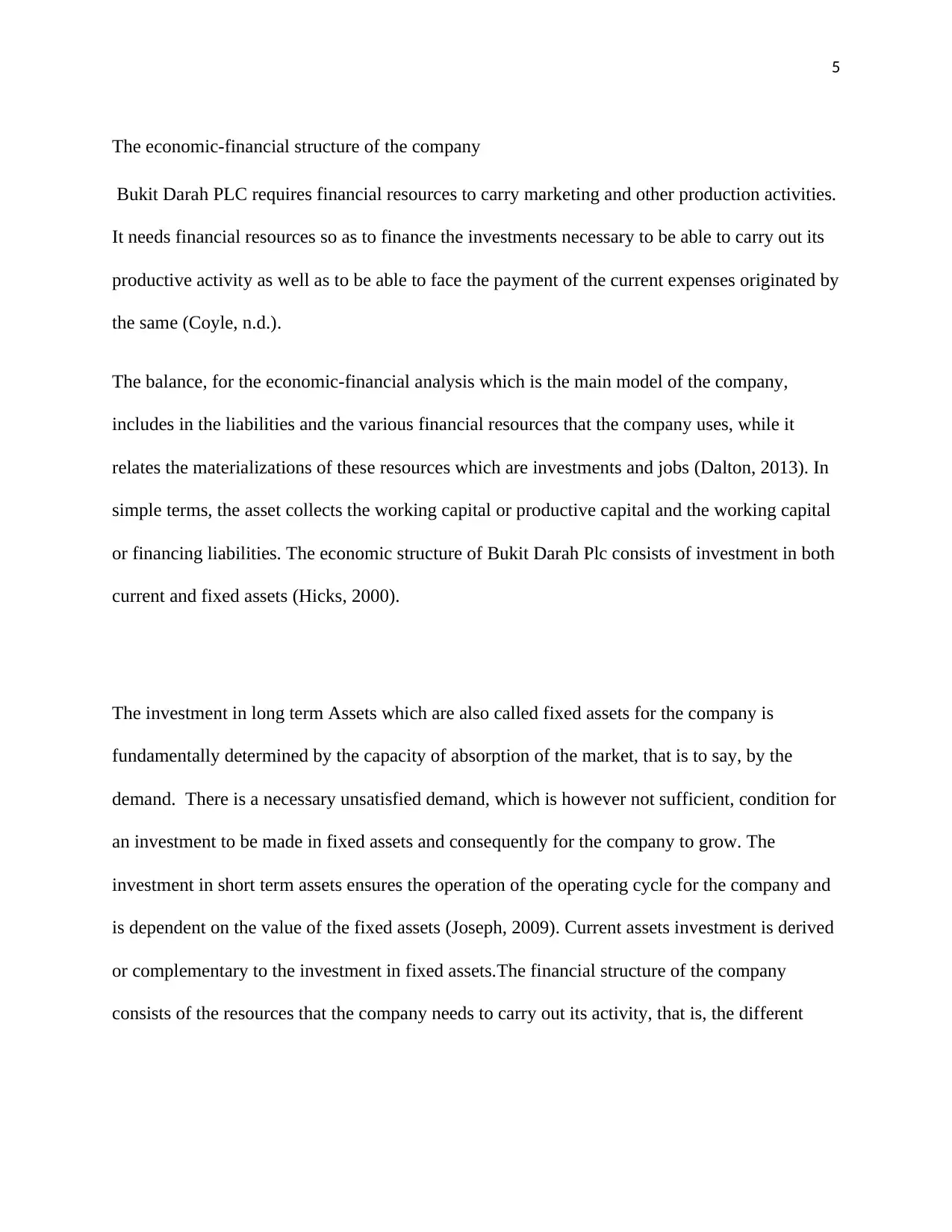
5
The economic-financial structure of the company
Bukit Darah PLC requires financial resources to carry marketing and other production activities.
It needs financial resources so as to finance the investments necessary to be able to carry out its
productive activity as well as to be able to face the payment of the current expenses originated by
the same (Coyle, n.d.).
The balance, for the economic-financial analysis which is the main model of the company,
includes in the liabilities and the various financial resources that the company uses, while it
relates the materializations of these resources which are investments and jobs (Dalton, 2013). In
simple terms, the asset collects the working capital or productive capital and the working capital
or financing liabilities. The economic structure of Bukit Darah Plc consists of investment in both
current and fixed assets (Hicks, 2000).
The investment in long term Assets which are also called fixed assets for the company is
fundamentally determined by the capacity of absorption of the market, that is to say, by the
demand. There is a necessary unsatisfied demand, which is however not sufficient, condition for
an investment to be made in fixed assets and consequently for the company to grow. The
investment in short term assets ensures the operation of the operating cycle for the company and
is dependent on the value of the fixed assets (Joseph, 2009). Current assets investment is derived
or complementary to the investment in fixed assets.The financial structure of the company
consists of the resources that the company needs to carry out its activity, that is, the different
The economic-financial structure of the company
Bukit Darah PLC requires financial resources to carry marketing and other production activities.
It needs financial resources so as to finance the investments necessary to be able to carry out its
productive activity as well as to be able to face the payment of the current expenses originated by
the same (Coyle, n.d.).
The balance, for the economic-financial analysis which is the main model of the company,
includes in the liabilities and the various financial resources that the company uses, while it
relates the materializations of these resources which are investments and jobs (Dalton, 2013). In
simple terms, the asset collects the working capital or productive capital and the working capital
or financing liabilities. The economic structure of Bukit Darah Plc consists of investment in both
current and fixed assets (Hicks, 2000).
The investment in long term Assets which are also called fixed assets for the company is
fundamentally determined by the capacity of absorption of the market, that is to say, by the
demand. There is a necessary unsatisfied demand, which is however not sufficient, condition for
an investment to be made in fixed assets and consequently for the company to grow. The
investment in short term assets ensures the operation of the operating cycle for the company and
is dependent on the value of the fixed assets (Joseph, 2009). Current assets investment is derived
or complementary to the investment in fixed assets.The financial structure of the company
consists of the resources that the company needs to carry out its activity, that is, the different
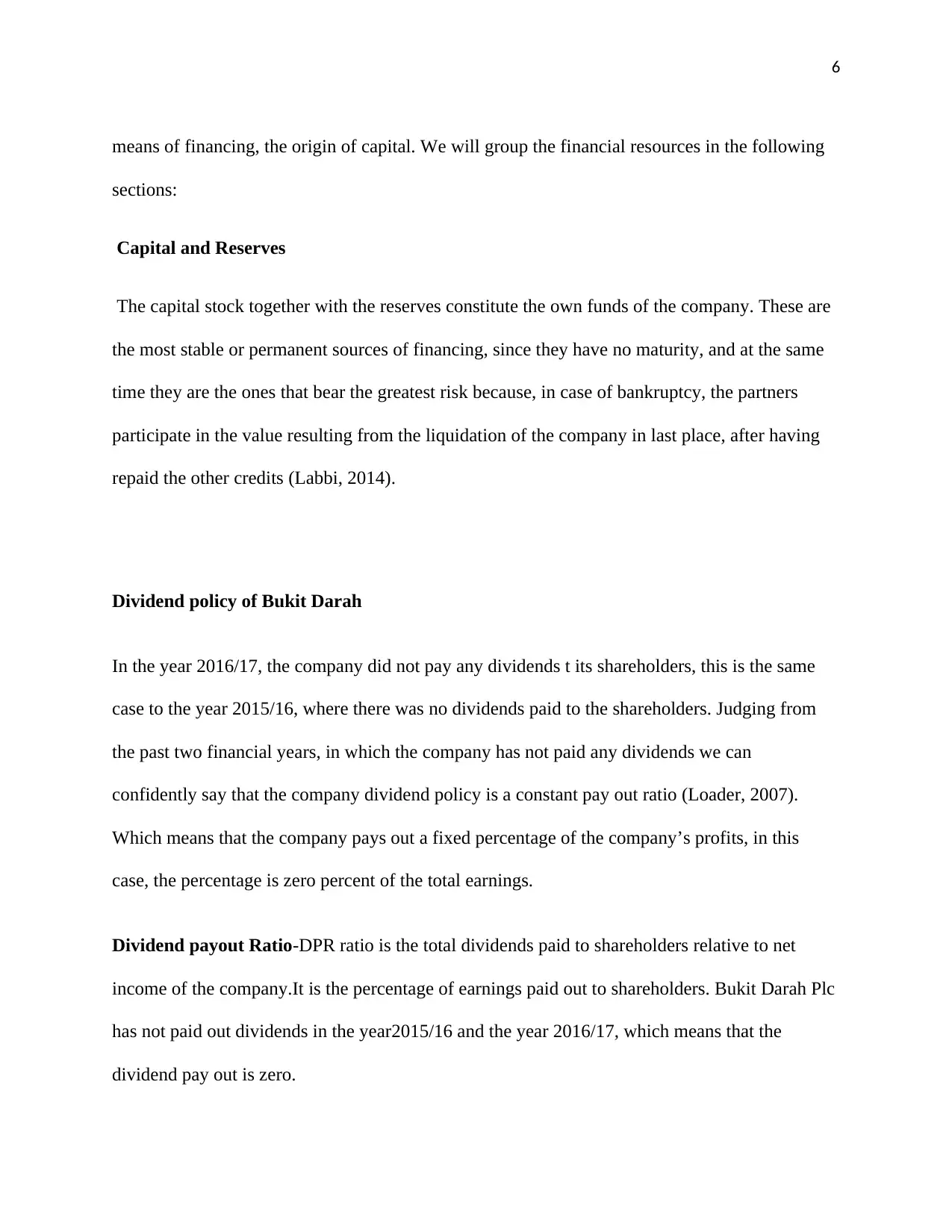
6
means of financing, the origin of capital. We will group the financial resources in the following
sections:
Capital and Reserves
The capital stock together with the reserves constitute the own funds of the company. These are
the most stable or permanent sources of financing, since they have no maturity, and at the same
time they are the ones that bear the greatest risk because, in case of bankruptcy, the partners
participate in the value resulting from the liquidation of the company in last place, after having
repaid the other credits (Labbi, 2014).
Dividend policy of Bukit Darah
In the year 2016/17, the company did not pay any dividends t its shareholders, this is the same
case to the year 2015/16, where there was no dividends paid to the shareholders. Judging from
the past two financial years, in which the company has not paid any dividends we can
confidently say that the company dividend policy is a constant pay out ratio (Loader, 2007).
Which means that the company pays out a fixed percentage of the company’s profits, in this
case, the percentage is zero percent of the total earnings.
Dividend payout Ratio-DPR ratio is the total dividends paid to shareholders relative to net
income of the company.It is the percentage of earnings paid out to shareholders. Bukit Darah Plc
has not paid out dividends in the year2015/16 and the year 2016/17, which means that the
dividend pay out is zero.
means of financing, the origin of capital. We will group the financial resources in the following
sections:
Capital and Reserves
The capital stock together with the reserves constitute the own funds of the company. These are
the most stable or permanent sources of financing, since they have no maturity, and at the same
time they are the ones that bear the greatest risk because, in case of bankruptcy, the partners
participate in the value resulting from the liquidation of the company in last place, after having
repaid the other credits (Labbi, 2014).
Dividend policy of Bukit Darah
In the year 2016/17, the company did not pay any dividends t its shareholders, this is the same
case to the year 2015/16, where there was no dividends paid to the shareholders. Judging from
the past two financial years, in which the company has not paid any dividends we can
confidently say that the company dividend policy is a constant pay out ratio (Loader, 2007).
Which means that the company pays out a fixed percentage of the company’s profits, in this
case, the percentage is zero percent of the total earnings.
Dividend payout Ratio-DPR ratio is the total dividends paid to shareholders relative to net
income of the company.It is the percentage of earnings paid out to shareholders. Bukit Darah Plc
has not paid out dividends in the year2015/16 and the year 2016/17, which means that the
dividend pay out is zero.
⊘ This is a preview!⊘
Do you want full access?
Subscribe today to unlock all pages.

Trusted by 1+ million students worldwide
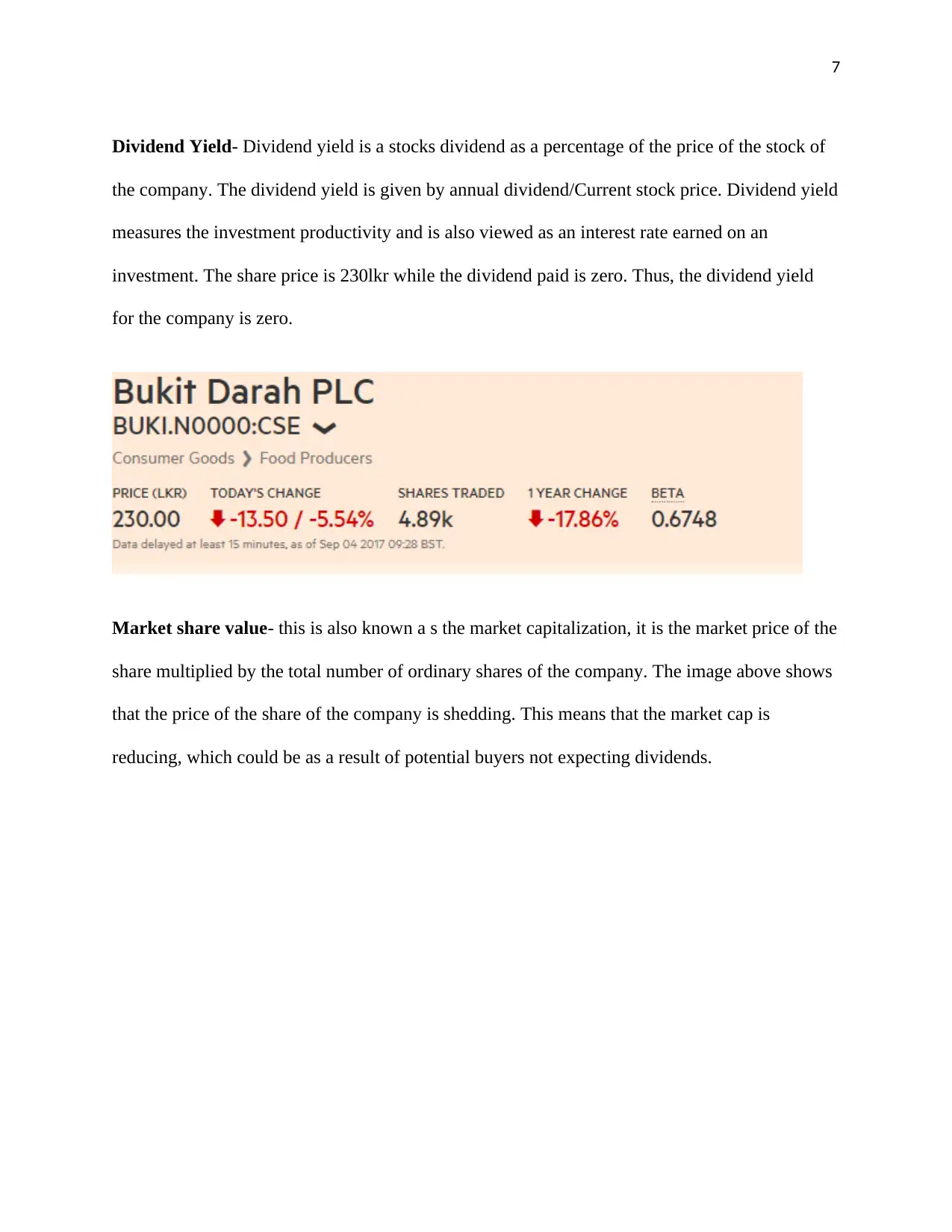
7
Dividend Yield- Dividend yield is a stocks dividend as a percentage of the price of the stock of
the company. The dividend yield is given by annual dividend/Current stock price. Dividend yield
measures the investment productivity and is also viewed as an interest rate earned on an
investment. The share price is 230lkr while the dividend paid is zero. Thus, the dividend yield
for the company is zero.
Market share value- this is also known a s the market capitalization, it is the market price of the
share multiplied by the total number of ordinary shares of the company. The image above shows
that the price of the share of the company is shedding. This means that the market cap is
reducing, which could be as a result of potential buyers not expecting dividends.
Dividend Yield- Dividend yield is a stocks dividend as a percentage of the price of the stock of
the company. The dividend yield is given by annual dividend/Current stock price. Dividend yield
measures the investment productivity and is also viewed as an interest rate earned on an
investment. The share price is 230lkr while the dividend paid is zero. Thus, the dividend yield
for the company is zero.
Market share value- this is also known a s the market capitalization, it is the market price of the
share multiplied by the total number of ordinary shares of the company. The image above shows
that the price of the share of the company is shedding. This means that the market cap is
reducing, which could be as a result of potential buyers not expecting dividends.
Paraphrase This Document
Need a fresh take? Get an instant paraphrase of this document with our AI Paraphraser
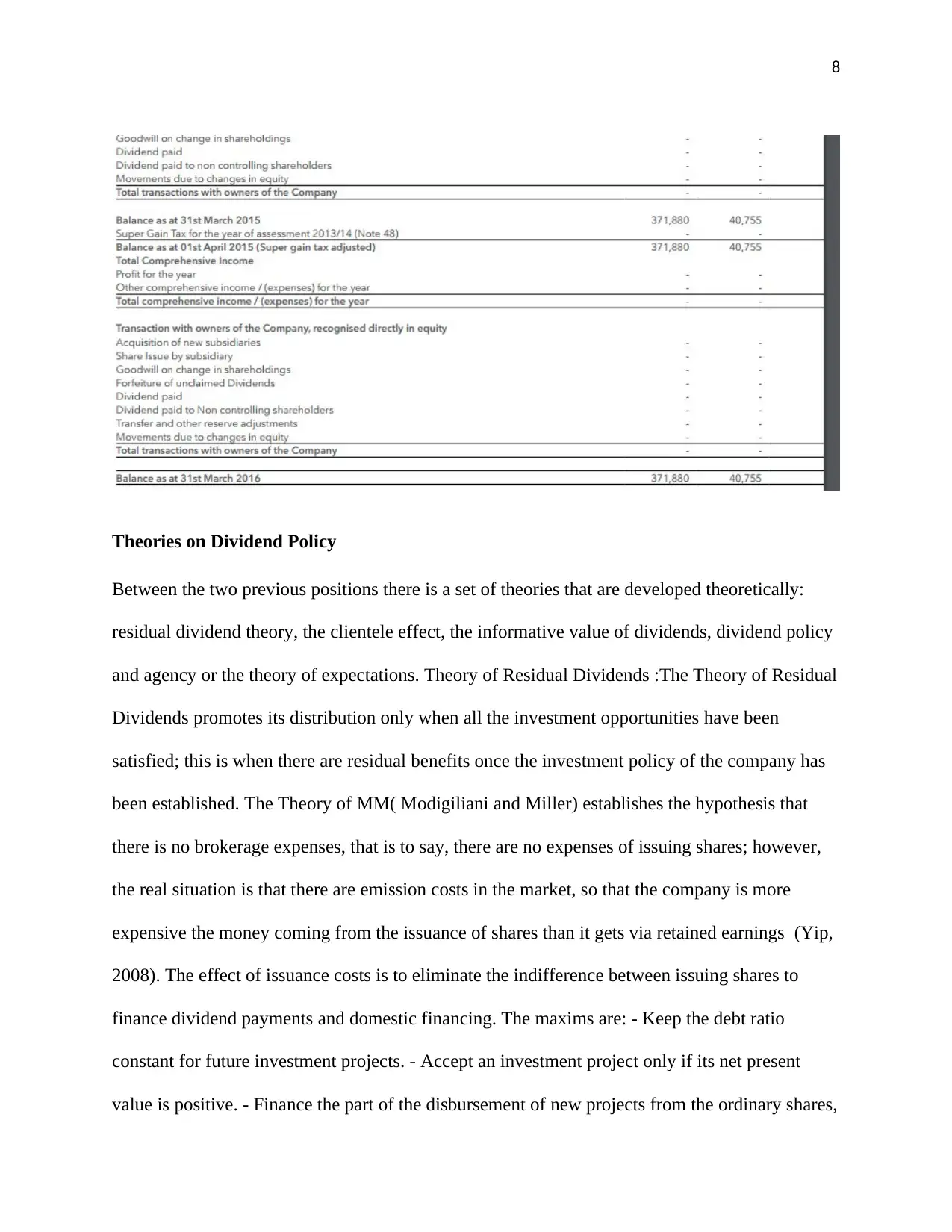
8
Theories on Dividend Policy
Between the two previous positions there is a set of theories that are developed theoretically:
residual dividend theory, the clientele effect, the informative value of dividends, dividend policy
and agency or the theory of expectations. Theory of Residual Dividends :The Theory of Residual
Dividends promotes its distribution only when all the investment opportunities have been
satisfied; this is when there are residual benefits once the investment policy of the company has
been established. The Theory of MM( Modigiliani and Miller) establishes the hypothesis that
there is no brokerage expenses, that is to say, there are no expenses of issuing shares; however,
the real situation is that there are emission costs in the market, so that the company is more
expensive the money coming from the issuance of shares than it gets via retained earnings (Yip,
2008). The effect of issuance costs is to eliminate the indifference between issuing shares to
finance dividend payments and domestic financing. The maxims are: - Keep the debt ratio
constant for future investment projects. - Accept an investment project only if its net present
value is positive. - Finance the part of the disbursement of new projects from the ordinary shares,
Theories on Dividend Policy
Between the two previous positions there is a set of theories that are developed theoretically:
residual dividend theory, the clientele effect, the informative value of dividends, dividend policy
and agency or the theory of expectations. Theory of Residual Dividends :The Theory of Residual
Dividends promotes its distribution only when all the investment opportunities have been
satisfied; this is when there are residual benefits once the investment policy of the company has
been established. The Theory of MM( Modigiliani and Miller) establishes the hypothesis that
there is no brokerage expenses, that is to say, there are no expenses of issuing shares; however,
the real situation is that there are emission costs in the market, so that the company is more
expensive the money coming from the issuance of shares than it gets via retained earnings (Yip,
2008). The effect of issuance costs is to eliminate the indifference between issuing shares to
finance dividend payments and domestic financing. The maxims are: - Keep the debt ratio
constant for future investment projects. - Accept an investment project only if its net present
value is positive. - Finance the part of the disbursement of new projects from the ordinary shares,
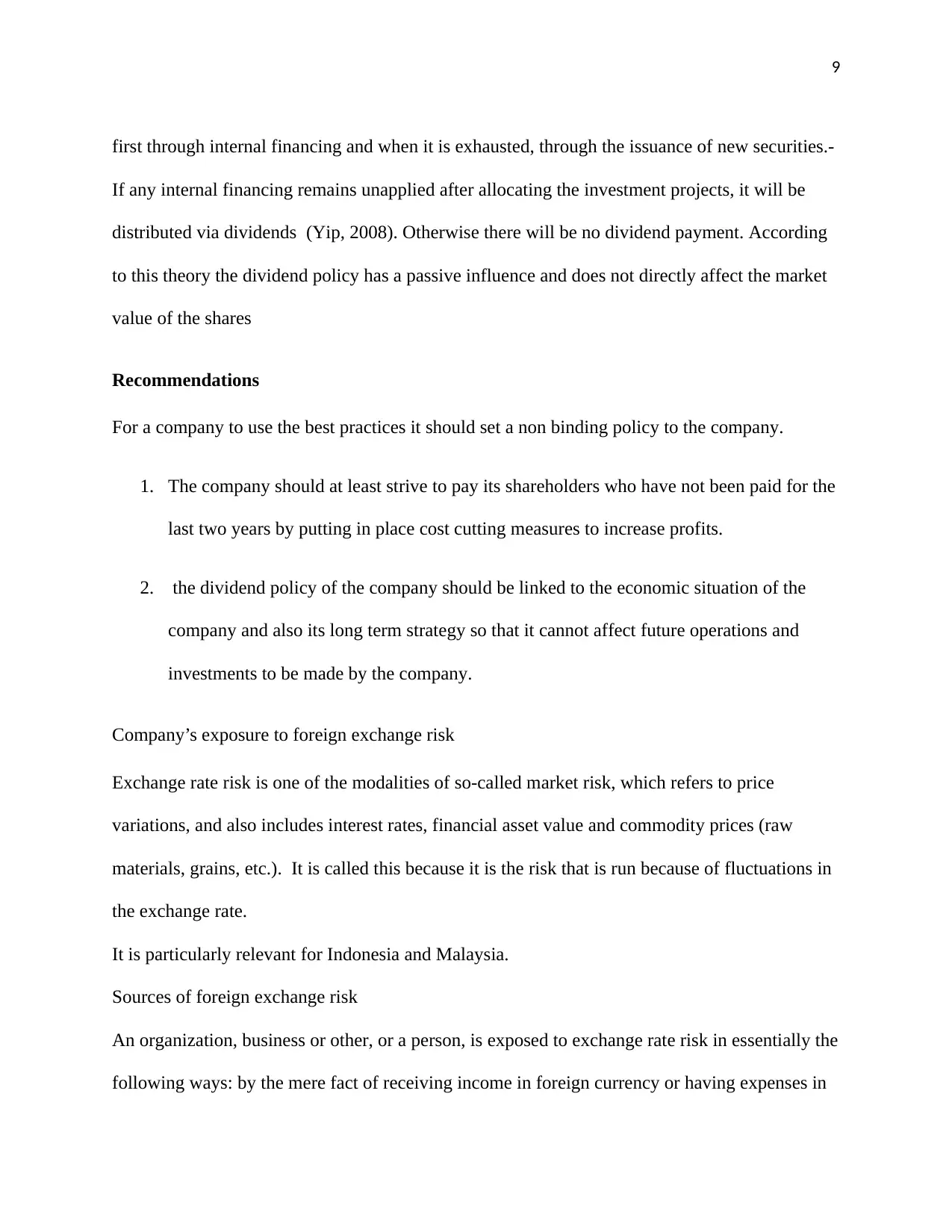
9
first through internal financing and when it is exhausted, through the issuance of new securities.-
If any internal financing remains unapplied after allocating the investment projects, it will be
distributed via dividends (Yip, 2008). Otherwise there will be no dividend payment. According
to this theory the dividend policy has a passive influence and does not directly affect the market
value of the shares
Recommendations
For a company to use the best practices it should set a non binding policy to the company.
1. The company should at least strive to pay its shareholders who have not been paid for the
last two years by putting in place cost cutting measures to increase profits.
2. the dividend policy of the company should be linked to the economic situation of the
company and also its long term strategy so that it cannot affect future operations and
investments to be made by the company.
Company’s exposure to foreign exchange risk
Exchange rate risk is one of the modalities of so-called market risk, which refers to price
variations, and also includes interest rates, financial asset value and commodity prices (raw
materials, grains, etc.). It is called this because it is the risk that is run because of fluctuations in
the exchange rate.
It is particularly relevant for Indonesia and Malaysia.
Sources of foreign exchange risk
An organization, business or other, or a person, is exposed to exchange rate risk in essentially the
following ways: by the mere fact of receiving income in foreign currency or having expenses in
first through internal financing and when it is exhausted, through the issuance of new securities.-
If any internal financing remains unapplied after allocating the investment projects, it will be
distributed via dividends (Yip, 2008). Otherwise there will be no dividend payment. According
to this theory the dividend policy has a passive influence and does not directly affect the market
value of the shares
Recommendations
For a company to use the best practices it should set a non binding policy to the company.
1. The company should at least strive to pay its shareholders who have not been paid for the
last two years by putting in place cost cutting measures to increase profits.
2. the dividend policy of the company should be linked to the economic situation of the
company and also its long term strategy so that it cannot affect future operations and
investments to be made by the company.
Company’s exposure to foreign exchange risk
Exchange rate risk is one of the modalities of so-called market risk, which refers to price
variations, and also includes interest rates, financial asset value and commodity prices (raw
materials, grains, etc.). It is called this because it is the risk that is run because of fluctuations in
the exchange rate.
It is particularly relevant for Indonesia and Malaysia.
Sources of foreign exchange risk
An organization, business or other, or a person, is exposed to exchange rate risk in essentially the
following ways: by the mere fact of receiving income in foreign currency or having expenses in
⊘ This is a preview!⊘
Do you want full access?
Subscribe today to unlock all pages.

Trusted by 1+ million students worldwide
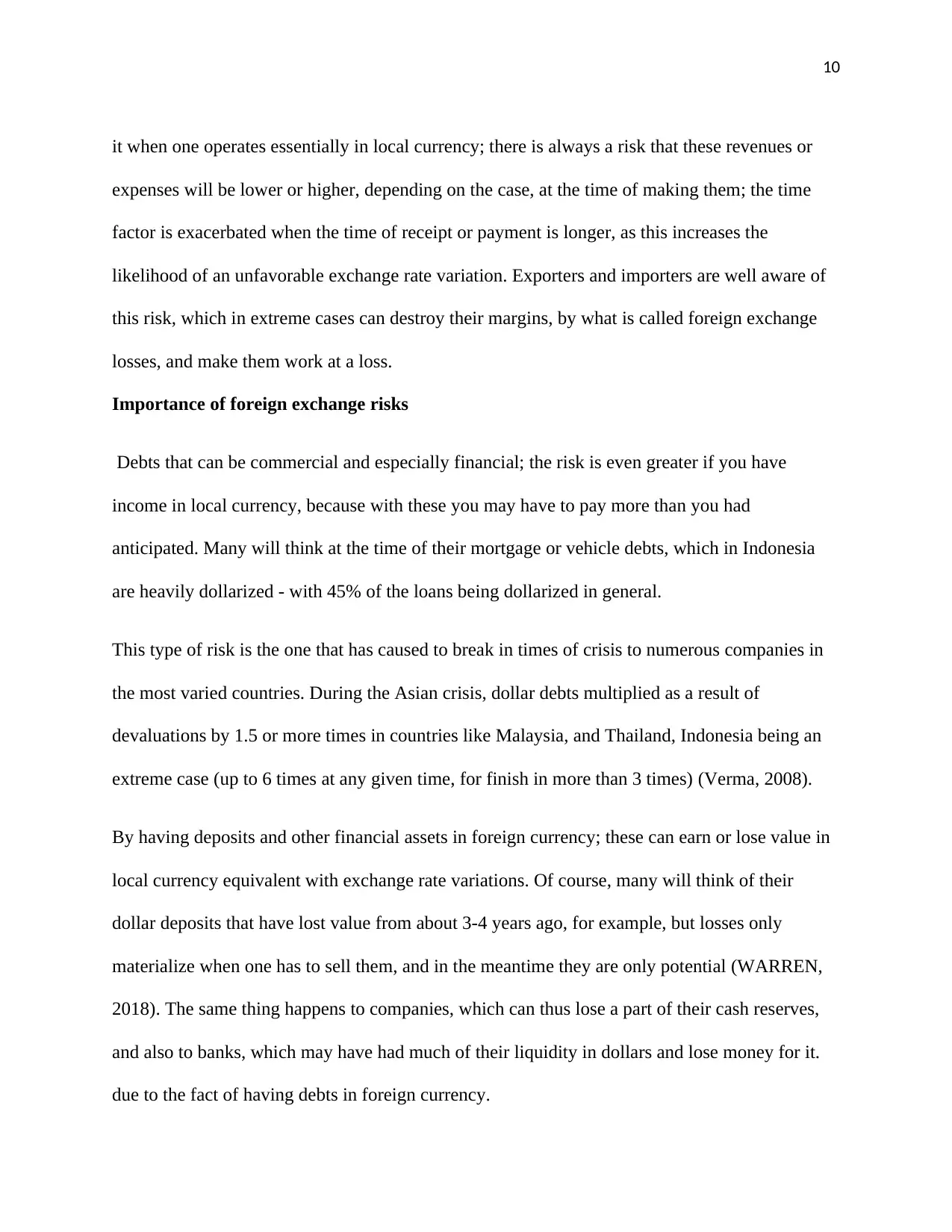
10
it when one operates essentially in local currency; there is always a risk that these revenues or
expenses will be lower or higher, depending on the case, at the time of making them; the time
factor is exacerbated when the time of receipt or payment is longer, as this increases the
likelihood of an unfavorable exchange rate variation. Exporters and importers are well aware of
this risk, which in extreme cases can destroy their margins, by what is called foreign exchange
losses, and make them work at a loss.
Importance of foreign exchange risks
Debts that can be commercial and especially financial; the risk is even greater if you have
income in local currency, because with these you may have to pay more than you had
anticipated. Many will think at the time of their mortgage or vehicle debts, which in Indonesia
are heavily dollarized - with 45% of the loans being dollarized in general.
This type of risk is the one that has caused to break in times of crisis to numerous companies in
the most varied countries. During the Asian crisis, dollar debts multiplied as a result of
devaluations by 1.5 or more times in countries like Malaysia, and Thailand, Indonesia being an
extreme case (up to 6 times at any given time, for finish in more than 3 times) (Verma, 2008).
By having deposits and other financial assets in foreign currency; these can earn or lose value in
local currency equivalent with exchange rate variations. Of course, many will think of their
dollar deposits that have lost value from about 3-4 years ago, for example, but losses only
materialize when one has to sell them, and in the meantime they are only potential (WARREN,
2018). The same thing happens to companies, which can thus lose a part of their cash reserves,
and also to banks, which may have had much of their liquidity in dollars and lose money for it.
due to the fact of having debts in foreign currency.
it when one operates essentially in local currency; there is always a risk that these revenues or
expenses will be lower or higher, depending on the case, at the time of making them; the time
factor is exacerbated when the time of receipt or payment is longer, as this increases the
likelihood of an unfavorable exchange rate variation. Exporters and importers are well aware of
this risk, which in extreme cases can destroy their margins, by what is called foreign exchange
losses, and make them work at a loss.
Importance of foreign exchange risks
Debts that can be commercial and especially financial; the risk is even greater if you have
income in local currency, because with these you may have to pay more than you had
anticipated. Many will think at the time of their mortgage or vehicle debts, which in Indonesia
are heavily dollarized - with 45% of the loans being dollarized in general.
This type of risk is the one that has caused to break in times of crisis to numerous companies in
the most varied countries. During the Asian crisis, dollar debts multiplied as a result of
devaluations by 1.5 or more times in countries like Malaysia, and Thailand, Indonesia being an
extreme case (up to 6 times at any given time, for finish in more than 3 times) (Verma, 2008).
By having deposits and other financial assets in foreign currency; these can earn or lose value in
local currency equivalent with exchange rate variations. Of course, many will think of their
dollar deposits that have lost value from about 3-4 years ago, for example, but losses only
materialize when one has to sell them, and in the meantime they are only potential (WARREN,
2018). The same thing happens to companies, which can thus lose a part of their cash reserves,
and also to banks, which may have had much of their liquidity in dollars and lose money for it.
due to the fact of having debts in foreign currency.
Paraphrase This Document
Need a fresh take? Get an instant paraphrase of this document with our AI Paraphraser
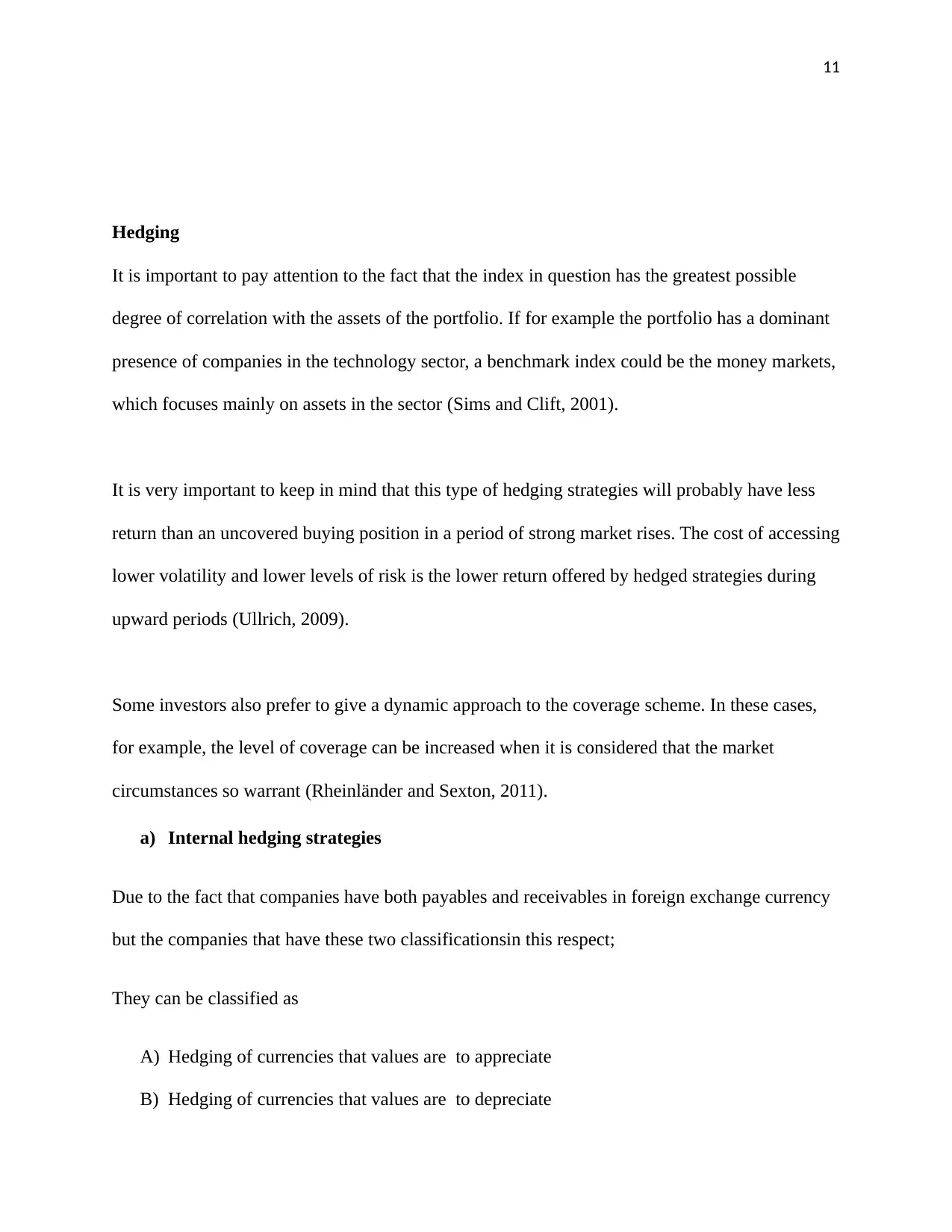
11
Hedging
It is important to pay attention to the fact that the index in question has the greatest possible
degree of correlation with the assets of the portfolio. If for example the portfolio has a dominant
presence of companies in the technology sector, a benchmark index could be the money markets,
which focuses mainly on assets in the sector (Sims and Clift, 2001).
It is very important to keep in mind that this type of hedging strategies will probably have less
return than an uncovered buying position in a period of strong market rises. The cost of accessing
lower volatility and lower levels of risk is the lower return offered by hedged strategies during
upward periods (Ullrich, 2009).
Some investors also prefer to give a dynamic approach to the coverage scheme. In these cases,
for example, the level of coverage can be increased when it is considered that the market
circumstances so warrant (Rheinländer and Sexton, 2011) .
a) Internal hedging strategies
Due to the fact that companies have both payables and receivables in foreign exchange currency
but the companies that have these two classificationsin this respect;
They can be classified as
A) Hedging of currencies that values are to appreciate
B) Hedging of currencies that values are to depreciate
Hedging
It is important to pay attention to the fact that the index in question has the greatest possible
degree of correlation with the assets of the portfolio. If for example the portfolio has a dominant
presence of companies in the technology sector, a benchmark index could be the money markets,
which focuses mainly on assets in the sector (Sims and Clift, 2001).
It is very important to keep in mind that this type of hedging strategies will probably have less
return than an uncovered buying position in a period of strong market rises. The cost of accessing
lower volatility and lower levels of risk is the lower return offered by hedged strategies during
upward periods (Ullrich, 2009).
Some investors also prefer to give a dynamic approach to the coverage scheme. In these cases,
for example, the level of coverage can be increased when it is considered that the market
circumstances so warrant (Rheinländer and Sexton, 2011) .
a) Internal hedging strategies
Due to the fact that companies have both payables and receivables in foreign exchange currency
but the companies that have these two classificationsin this respect;
They can be classified as
A) Hedging of currencies that values are to appreciate
B) Hedging of currencies that values are to depreciate
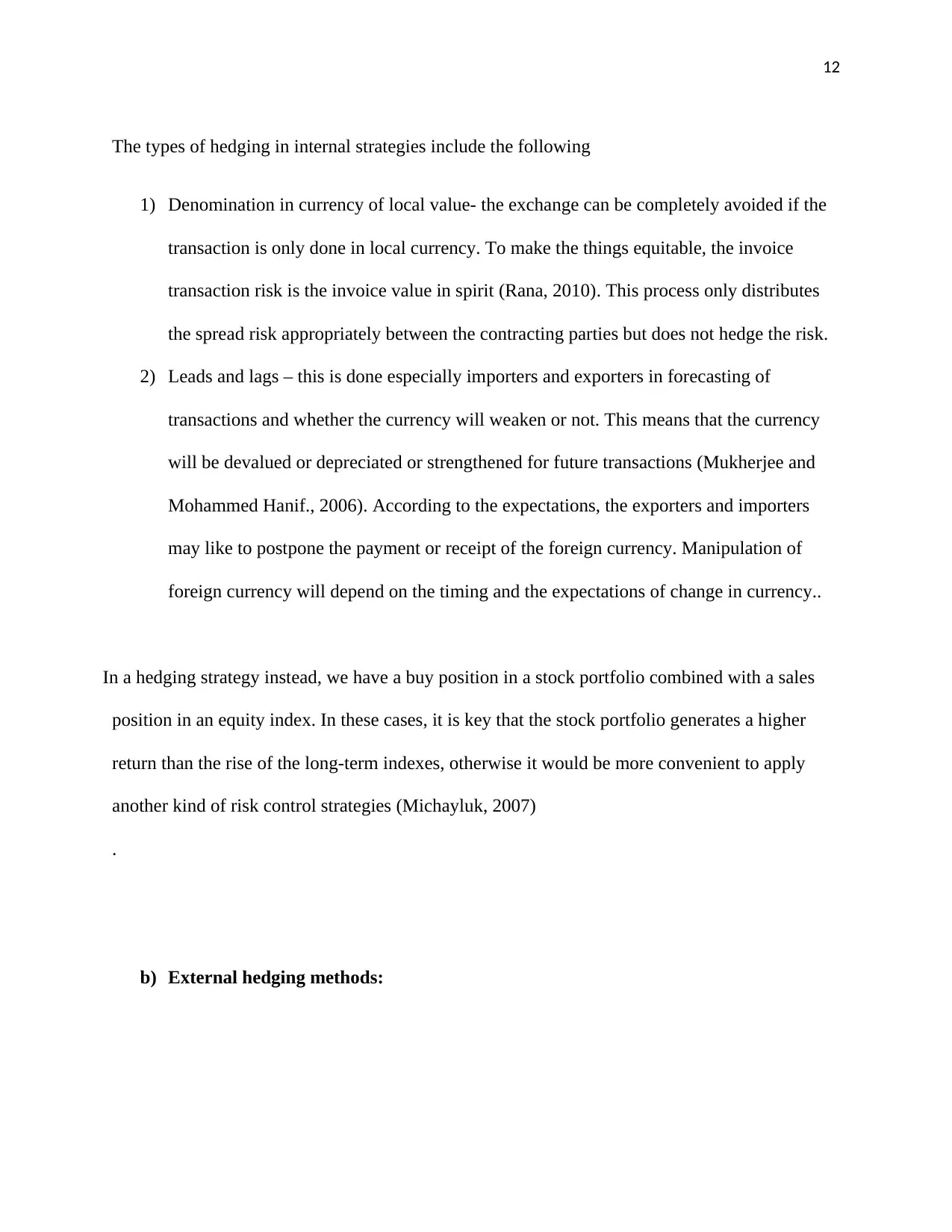
12
The types of hedging in internal strategies include the following
1) Denomination in currency of local value- the exchange can be completely avoided if the
transaction is only done in local currency. To make the things equitable, the invoice
transaction risk is the invoice value in spirit (Rana, 2010). This process only distributes
the spread risk appropriately between the contracting parties but does not hedge the risk.
2) Leads and lags – this is done especially importers and exporters in forecasting of
transactions and whether the currency will weaken or not. This means that the currency
will be devalued or depreciated or strengthened for future transactions (Mukherjee and
Mohammed Hanif., 2006). According to the expectations, the exporters and importers
may like to postpone the payment or receipt of the foreign currency. Manipulation of
foreign currency will depend on the timing and the expectations of change in currency..
In a hedging strategy instead, we have a buy position in a stock portfolio combined with a sales
position in an equity index. In these cases, it is key that the stock portfolio generates a higher
return than the rise of the long-term indexes, otherwise it would be more convenient to apply
another kind of risk control strategies (Michayluk, 2007)
.
b) External hedging methods:
The types of hedging in internal strategies include the following
1) Denomination in currency of local value- the exchange can be completely avoided if the
transaction is only done in local currency. To make the things equitable, the invoice
transaction risk is the invoice value in spirit (Rana, 2010). This process only distributes
the spread risk appropriately between the contracting parties but does not hedge the risk.
2) Leads and lags – this is done especially importers and exporters in forecasting of
transactions and whether the currency will weaken or not. This means that the currency
will be devalued or depreciated or strengthened for future transactions (Mukherjee and
Mohammed Hanif., 2006). According to the expectations, the exporters and importers
may like to postpone the payment or receipt of the foreign currency. Manipulation of
foreign currency will depend on the timing and the expectations of change in currency..
In a hedging strategy instead, we have a buy position in a stock portfolio combined with a sales
position in an equity index. In these cases, it is key that the stock portfolio generates a higher
return than the rise of the long-term indexes, otherwise it would be more convenient to apply
another kind of risk control strategies (Michayluk, 2007)
.
b) External hedging methods:
⊘ This is a preview!⊘
Do you want full access?
Subscribe today to unlock all pages.

Trusted by 1+ million students worldwide
1 out of 16
Related Documents
Your All-in-One AI-Powered Toolkit for Academic Success.
+13062052269
info@desklib.com
Available 24*7 on WhatsApp / Email
![[object Object]](/_next/static/media/star-bottom.7253800d.svg)
Unlock your academic potential
Copyright © 2020–2025 A2Z Services. All Rights Reserved. Developed and managed by ZUCOL.





